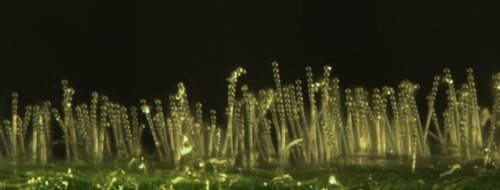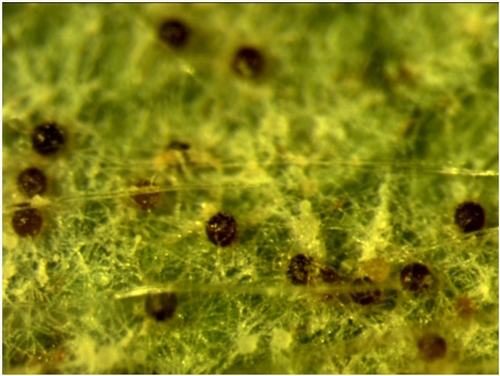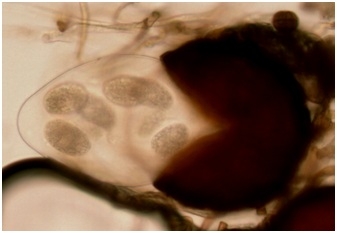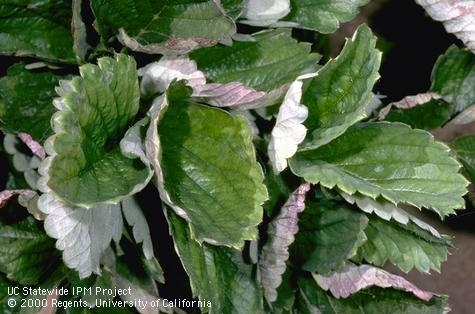Identity is an important issue whether it is for an individual, a company or even a disease causing organism. In this case, it is the plant pathogenic fungus that causes powdery mildew on strawberries and several other crops. I recently attended some talks about strawberry diseases and found out that powdery mildew pathogen, previously known as Sphaerotheca macularis, is now referred to as Podosphaera aphanis. Literature search indicated that this name has been used for a few years. I have contacted Dr. David Gadoury, a senior research associate and powdery mildew specialist from Cornell Univeristy, whose talk I attended, to elaborate on the name change. Below is what he says:
“Although the causal agent of strawberry powdery mildew has long been known by the name Sphaerotheca macularis, it has more recently been reclassified as Podosphaera aphanis. Classification of all powdery mildews before 1980 was largely based upon features of the overwintering structures or fruiting bodies called cleistothecia. In particular, genera of powdery mildews were grouped and named based upon the numbers of spore containing sacs known as asci (singular ascus) in the cleistothecium and the morphology of the appendages of the cleistothecia, in particular the appendage tips. The foregoing system has been largely supplanted by the phylogeny (history of evolutionary relationships) of powdery mildew fungi inferred from internal transcribed spacer (ITS) of ribosomal DNA sequences, which correlates with conidial ontogeny (developmental changes) and morphology (structure) (Braunet al., 2002). Although such details may fascinate taxonomists, the bottom line for those concerned with the practical aspects of disease management is this: the fungus has a new name, but it's the same pathogen, not a new one that has recently attacked strawberries.
Going forward, in particular when searching for information in electronic resources, it will become increasingly important to remember that the name was recently changed. The more recent literature is most likely to be found using the new name: Podosphaera aphanis.”

Conidial chains borne atop conidiophores. It is these stalk-like conidiophores that give mildew colonies their powdery appearance. Spores form at the bottom of the chain, so the oldest spores are at the tip of the chain. They break off in wind currents and can travel short distances, generally less than 100 meters. (Photo and description by David Gadoury, Cornell University)

Cleistothecia are the overwintering structures of powdery mildews (dark, round structures in picture). They are firmly embedded in the threads of the fungal growth (mycelium) on the leaf surface. (Photo and description by David Gadoury, Cornell University)

Cleistothecium with ascus containing ascospores. The cleistothecium swells when coated with a film of water and fractures. The ascus is an elastic sac that continues to absorb water and swell, eventually bursting and ejecting the ascospores into the air. Appendages of the genus Podosphaera are simple with unbranched tips, and the cleistothecia contain only a single ascus. (Photo and description by David Gadoury, Cornell University)
Although it is the same pathogen, it is important to know the new name as it will eventually be updated in all publications. It is even more important when we look for recent updates as it is very likely to have the new name.
Brief description about the disease and symptoms: Powdery mildew is an important disease causing damage to leaves, flowers, and fruit and affecting the fruit yield and quality. Typical symptoms include white, powdery fungal growth on the lower surface of the leaves, upward curling of the leaf edges, and dry, purplish patches on the upper leaf surface as the disease advances. Dry leaf surfaces, cool to warm temperatures and high humidity favor the infection. Fungal spores are disseminated by wind and cause further infection. Recent studies indicate that cleistothecia serve as functional source of primary inoculum (Gadoury et al., 2010). Resistance of leaves and berries to the infection significantly increases as they mature (Gadoury et al., 2007, Asalf et al., 2009, Carisse and Bouchard, 2010).

Infection symptoms: Upward curling of the leaf edges and powdery growth
(Photo by Jack Kelly Clark)
Management: Clean nursery stock is very important to prevent the introduction to the production fields and can reduce the need for fungicidal applications. Fungicidal treatment prior to the onset of symptoms is critical for effective and sustainable suppression of the disease. Gadoury said that the choice of materials is generally secondary to proper timing and thorough coverage of the young, susceptible leaves, flowers, and fruit. “Keep in mind that the mildew colonies that you see result from infections that occurred up to four weeks before they became visible to the naked eye,” said Gaoudy. “Waiting until disease is apparent will result in poor control and hasten development of resistance in many of the remaining effective fungicides particularly those in the DMI and strolbilurin classes.”
You can refer to the UC pest management guidelines for additional information.
http://ucanr.edu/articlefeedback
References
Asalf, B., A. Stensvand, D. M. Gadoury, R. C. Seem, A. Dobson and A. M. Tronsmo. 2009. Ontogenic resistance to powdery mildew in strawberry fruits. Proc. 10th International Epidemiology Workshop. (eds. Gadoury, D.M., R. C. Seem, M. Moyer and W. E. Fry). Cornell University, New York. 177 pp.
Braun, U., R.T.A. Cook, A. J. Inman. and H. D. Shin. 2002. The taxonomy of the powdery mildew fungi. In The powder mildews: a comprehensive treatise (eds., Bélanger, R. R., W. R. Bushnell, A. J. Dik and T.L.W. Carver), pp. 13-55.
Carisse, O. and J. Bouchard. 2010. Age-related susceptibility of strawberry leaves and berries to infection by Podosphaera aphanis. Crop Protection 9: 969-978.
Gadoury, D.M., A. Stensvand, R. C. Seem, and C. Heidenreich. 2007. Ontogenic resistance of leaves, leaf folding and the distribution of mildew colonies in strawberry powdery mildew (Podosphaera macularis). Phytopathology 97:S38
Gadoury, D. M., B. Asalf, M. C. Heidenreich, M. L. Herrero, M. J. Wlser, R.C. Seem, A. M. Tronsmo and A. Stensvand. 2010. Initiation, development, and survival of cleistothecia of Podosphaera aphanis and their role in the epidemiology of strawberry powdery mildew. Phytopathology 100: 246-251.
